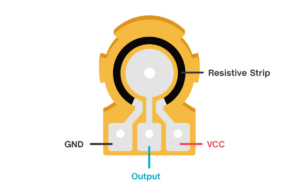Potentiometers, or ‘Pots’ as they are commonly known among engineers, are essentially resistors that incorporate a mechanical adjustment mechanism enabling their resistance to be changed manually. Resistors, as we know, offer a fixed resistance value and block or “resist” the flow of electrical current in a circuit. A potentiometer is fundamentally a variable resistor.
Potentiometers function as voltage dividers that can be used to both adjust voltage output to a circuit, and accurately measure (or meter) electric potential – hence the name potentiometer. They produce a continuously variable voltage output signal proportional to the physical position of the wiper on the resistive element. They are passive components, meaning that they do not need a power supply or additional circuits to function.
A brief of history of potentiometers
With the explosion in research on and development of electricity in the early 1800s, the thought of a component that could be used to control the amount of electricity going into a device or circuit was explored by many people, but the concept of the potentiometer was not proposed until 1841. It would take until 1872 for the first working carbon potentiometer to be invented by Thomas Edison.
The potentiometers available today are significantly smaller and more accurate than earlier devices and come in a large variety of types and packages, depending on the application. They are commonly used in devices and systems to control values, including light levels, audio volume and audio signals, and video brightness and colour. They can also function as position sensors.
How do potentiometers work?

Resistance of an object is reliant on several factors. With all else being held constant, the resistance of an object is directly proportional to its length. In other words, an object of the same material and the same size cross-section that is 10cm long will be half the resistance of another object that is 20cm long. Potentiometers use this principle. The adjustable output of a potentiometer is accomplished by varying the linear or rotary position of a sliding contact across a uniform resistance element, lengthening, or shortening the path that current flows through. Input voltage is applied across the entire length of the resistive element, and the output voltage is applied as the drop between the fixed resistive element and the sliding or rotating contact. The position of the movable contact across the resistive element determines the amount of input voltage that will be applied to the circuit.
Potentiometers are very rarely used to control more than a watt since the device must dissipate the input power and would produce unacceptable heat. They instead work by adjusting analogue signals used by other components to control power. For example, a simple light dimmer uses a potentiometer to control a TRIAC which varies the light brightness.
Find out more about potentiometers here.




